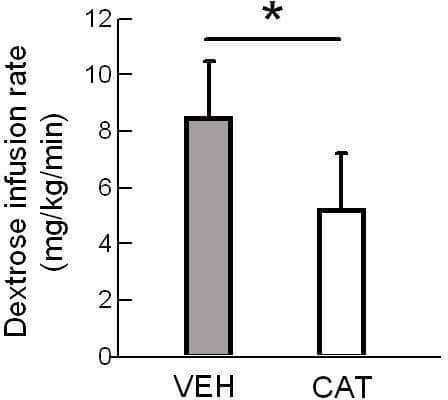There is increasing evidence that sensing of changes in blood glucose in the brain, particularly in the hypothalamus, plays a key role in controlling peripheral glucose homeostasis. Hypothalamic levels of reactive oxygen species (ROS) have been suggested to act as an indirect signal reflecting peripheral glucose levels, perhaps being generated by a glucose-dependent increase in flux through the mitochondrial electron transport chain. ROS consist of a number of different chemical compounds, including hydrogen peroxide which has also been implicated as a physiological neurotransmitter. We hypothesised, therefore, that lowering hypothalamic HP would be detected by nutrient sensors as a fall in circulating glucose and lead to a compensatory increase in endogenous glucose production/ decrease in insulin sensitivity. To test this hypothesis, we performed 180 minute hyperinsulinaemic euglycaemic pancreatic clamps (infusion of insulin 2 mU/kg/min and somatostatin 3 μg/kg/min) on adult Sprague Dawley rats with vascular and intracerebroventricular [ICV] catheters inserted 1 week previously under isoflurane anaesthesia. On study days, starting 90 min prior to clamps and then continuing until the end of studies, conscious free moving animals received an ICV infusion into the third ventricle of either the antioxidant catalase (to reduce hypothalamic hydrogen-peroxide levels) (CAT, n=6) or vehicle in controls (VEH, n=5). Using this insulin clamp technique, plasma glucose levels were adjusted to and maintained at equal levels of euglycaemia in both groups of rats (6.0 ± 0.3 vs 6.1 ± 0.3 mM vehicle and catalase infused rats respectively during the last 30 mins of clamps, p = NS). As shown in figure below, despite being maintained at equivalent plasma glucose, the requirements for exogenous dextrose infusion in the 2 groups were different. In keeping with our hypothesis, whole body insulin-sensitivity, as gauged by the dextrose infusion rates required to maintain euglycaemia during last 30 minutes of clamp studies, was significantly reduced in the ICV catalase group compared with vehicle controls (p<0.05). These data support our hypothesis that changing levels of ROS in the hypothalamus, specifically levels of hydrogen peroxide, are a key physiological factor controlling plasma glucose levels.
University of Oxford (2008) Proc Physiol Soc 12, C1 and PC11
Oral Communications: Peripheral glucose metabolism is controlled by hydrogen peroxide-mediated hypothalamic glucose-sensing
P. Markkula1, C. Yueh1, M. Osundiji1, S. Moore1, J. Shaw1, C. Riches1, T. Adeloye1, M. Evans1
1. Institute of Metabolic Science, University of Cambridge, Cambridge, United Kingdom.
View other abstracts by:
Figure shows significant reduction in dextrose infusion rates in ICV catalase rats during last 30 min of euglycaemic clamp (mg/kg/min)
Where applicable, experiments conform with Society ethical requirements.

